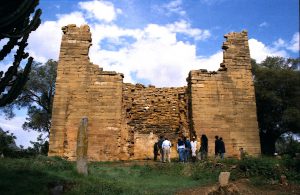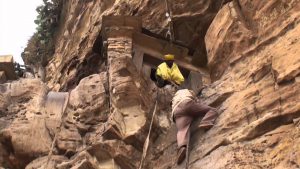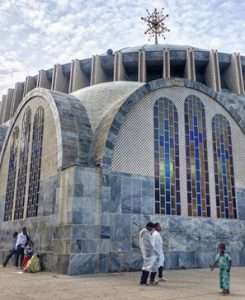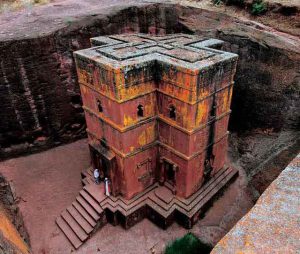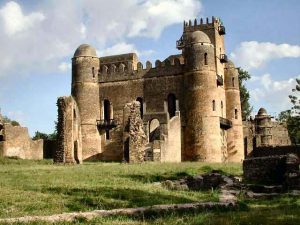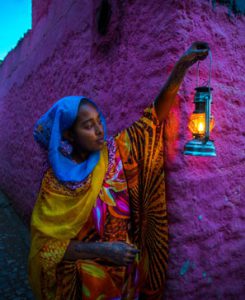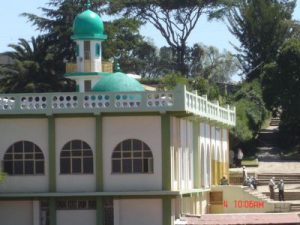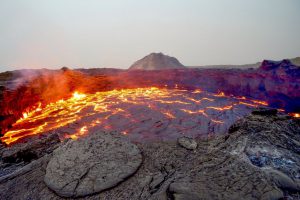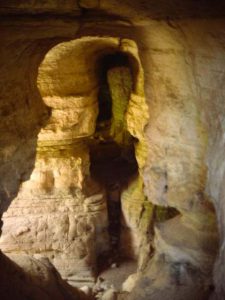Attractions
![]()
That Ethiopia has a heritage from the beginnings of mankind was underlined when the remains of ‘Lucy’, dated from 3.5 million years ago, and the 4.4 million year old Homo ramidus afarensis, man’s oldest anthropoid ancestor, were uncovered. Traders from Greece, Rome, Persia and Egypt knew of the riches of what is now Ethiopia, and by the first century AD, Axum was the capital of a great empire.
This realm became one of the first Christian lands of Africa. Late in the 10th century Axum declined and a new Zagwe dynasty, centered in what is now Lalibela, ruled the land. Axum, Lalibella and Gondar now provide our greatest historical legacy. It was in the 16th century that the son of the great explorer Vasco da Gama came to Ethiopia, but then found a land of many kingdoms and provinces beset feuds and wars. In the l9th century the great Emperor Menelik led us towards the modern state of Ethiopia, and the Country’s passage to modernization began.
Yeha
The oldest standing structure in Ethiopia is located in Yeha: the Great Temple. This is a tower built in the Sabaean style, and dated through comparison with dated structures in South Arabia to around 700 BC; although no radiocarbon dating testing has been performed on samples from Yeha, this date for the Great Tower is supported by local inscriptions.
David Phillipson attributes its “excellent preservation” to two factors, “the care with which its original builders ensured a level foundation, firmly placed on the uneven bedrock; and to its rededication — perhaps as early as the sixth century AD — for use as a Christian church.”
Debre Damo
Some 76 Kilometers from Axum is the monastery of Debre Damo ( closed to Women), which is said to have the oldest existing intact church in Ethiopia. Local tradition says that Abune Aregawi, one of the nine Saints, built the church in the 16th Century. The Monastery of Debre Damo can only be reached by rope pulley.
Axum
The settlement was also the site of Ethiopia’s oldest church, which dated back to the coming of Christianity as the state religion, early in the 4th Century. The giant stelae, the Axum Zion Church the ruin palaces tombs and many other archeological findings are all the symbols of the glorious Axumite Civilization signifying this ancient city as a center of Civilization, religion and Administrative.
The fallen obelisk with a height of 33 metres is the tallest obelisk carved out of a single stone. The 24 meter high obelisk is still standing and the other one with a height of 27 meters was cut in to three parts and taken to Rome in 1937 and returned back to Axum in 2005. They are all regarded as one of the finest examples of engineering from the height of the Axumite Empire.
Lalibela
Lalibela medieval settlement in the Lasta area of Wallo, lies at the centre of an extensive complex of rock churches. Some can be reached by one or two hours’ drive, others are a full day’s journey. Lalibela has 11 remarkable rock-hewn monolithic churches, believed to have been built by King Lalibela in the late 12th or early 13th Century.
These notable structures are carved, inside and out, into the solid rock, and are considered to be among the wonders of the world. Each building is architecturally unique but each reflects beautifully executed craftsmanship, and several are decorated with fascinating paintings. These astonishing edifices remain places of living worship to this day.
Gonder
Ethiopia went through a long period without a fixed capital. When it was time to have one, there was no better settlement than the one at Gonder. Besides being the largest settlement in the country, it was an important administrative, commercial, religious, and cultural center. It was also noted for the skills of its many craftsmen.
Gonder became the capital of Ethiopia during the reign of Emperor Faciladas (1632-1667). Faciladas was responsible for the building of the fist castle-like palaces, the most magnificent of all the castles. In most European cases, the single castle such as the above would have been sufficient to serve as palace for successive generations.
Harar
The old medieval walled city of Harar – a city of mosques, minarets, and markets, a centre of Muslim learning, a city which once struck its own local currency, and still has its own unique language – has long been regarded by the outside world as a city of mystery and romance.
The walls of Harar were pierced in early times by five gates, a number supposed to symbolize the Five Pillars of Islam. These gates, known to the Hararis as bari, were situated respectively to the north, east, south-east, south, and west of the city. Each had its own distinctive name, and provided entry and egress to caravans traveling to and from different stretches of the surrounding country.
Nejashi Mosque
The history of Negash begins from the 7th century AD; it is the place where the first mosque was constructed in Ethiopia. It is also serves as enduring reminder of the warm welcome extended by the Ethiopian king of the time Nejashi Ashama,when those Muslims including the family of the prophet Mohammed includes his daughter, his cousin and his wives filed from persecution from their own land and found refuge in Ethiopia. Negash is considered by many the second most sacred place of Islamic worship and also for Ethiopian Muslims as” the Second Mekkah”.
Cultural Attractions
Ethiopia is a rich mosaic of nations, nationality and peoples. It is an ancient famous land of diverse cultures, traditions, religions and values. Ethiopia has a diverse population, with more than 80 distinct ethnic and linguistic groups with different culture, religious and life style. While you are traveling at every corner of the country, you will admire and experience different kinds of religious celebrations, festivals, daily people’s life styles and the range of traditional customs. Some of this people cultures are far from being influenced by the so-called modernity. From these cultural attractions includes the southern nations and nationality peoples like the konso, Hamer, Surma, Mursi, Arbore, Karo, to name but a few. The religious festival which includes, Meskel (the finding of the true Crosse) Lidet or Gena (Christmas) Timket (Ethiopian epiphany) Fasika (Ethiopian Easter) are the mean tourist attraction in the country and a colorful festival in the country.
Geological Attractions
Ethiopia constitutes many Geological attraction like the great east Africa Rift, the afar Depression, Simien and the Bale massifs, the Sof-Omer Caves and blue Nile river are the major ones. The noticeable Geological attraction of Ethiopia is the Denakil Depression .Geologically one of the most active spots on the planet, located below-sea-level an average of -116. Dallol is one of the attractions in this area. It is an extremely hot and inhospitable place but you feel like you are in another planet. The relationship of the hot springs with the different kinds of minerals, form a mixture of colors. Erta Ale means the smoking mountain by Afar language. Erta Ale is one of the active lava lake in the world. The other interesting attraction of the place is the caravans of the camels for the extraction of “Amole Chew” the salt of bar.
Natural Ethiopia Attractions
The natural beauty of Ethiopia amazes the first-time visitor. Ethiopia is a land of rugged mountains ( some 25 are over 4000 meters high) broad savannah, lakes and rivers. The unique Rift Valley is a remarkable region of volcanic lakes, with their famous collections of birdlife, great escarpments and stunning vistas. Tisisat, the blue Nile falls, must rank as one of the greatest natural spectacles in Africa today.
Blue Nile
The Blue Nile is a river originating at Lake Tana in Ethiopia. With the White Nile, the river is one of the two major tributaries of the Nile. The upper reaches of the river is called the Abbay in Ethiopia, where it is considered holy by many, and is believed to be the River Gihon mentioned as flowing out of the Garden of Eden in Genesis . According to materials published by the Ethiopian Central Statistical Agency, the Blue Nile has a total length of 1,450 kilometres, of which 800 are inside Ethiopia.
Sof Omar Cave
Sof Omar, a tiny Muslim village in Bale, is the site of an amazing complex of natural caves, cut by the Weyb River as it found its way into the nearby mountains. The settlement, which is a religious site, is named after a local Sheikh. Visitors make their way-armed with torches and official maps underground, far into the bowels of the earth, beside a subterranean stream. There one can see an extraordinary number of arched portals, high, eroded ceilings and deep, echoing chambers.
Lake Tana
Lake Tana, the largest lake in Ethiopia, is the source and from where the famed Blue Nile starts its long journey to Khartoum, and on to the Mediterranean. The 37 islands that are scattered about the surface of the lake shelter fascinating churches and monasteries. Some of which have histories dating back to the 13th century. A sail or cruise on Lake Tana is one of the most pleasant excursions for visitors to this region, particularly in the heart of the summer.

